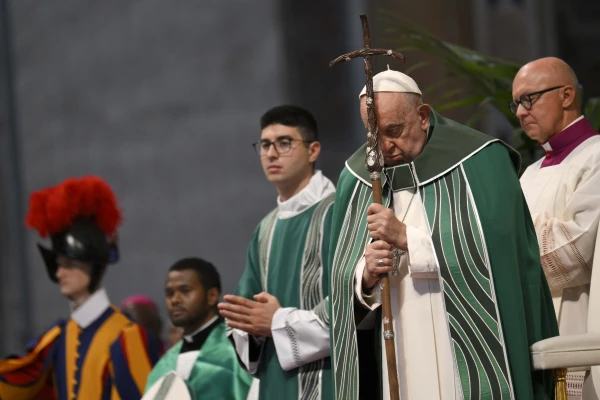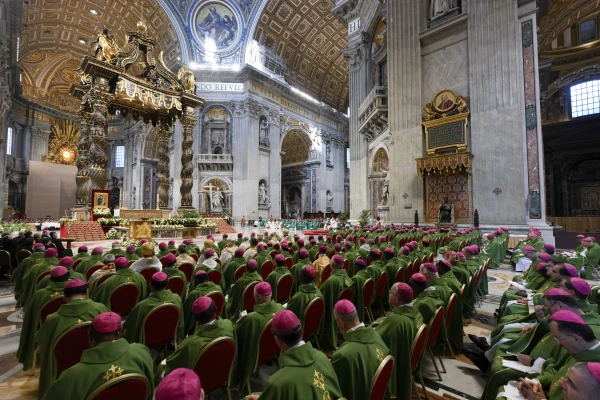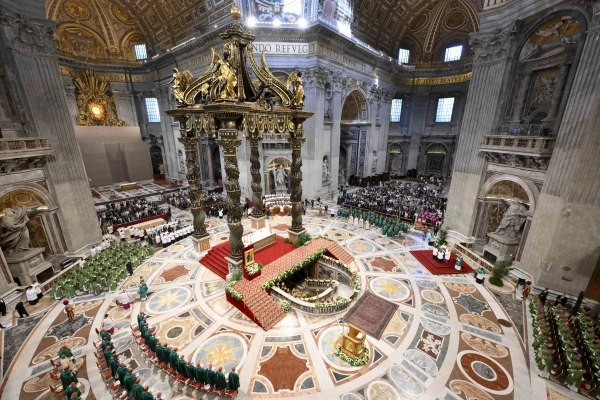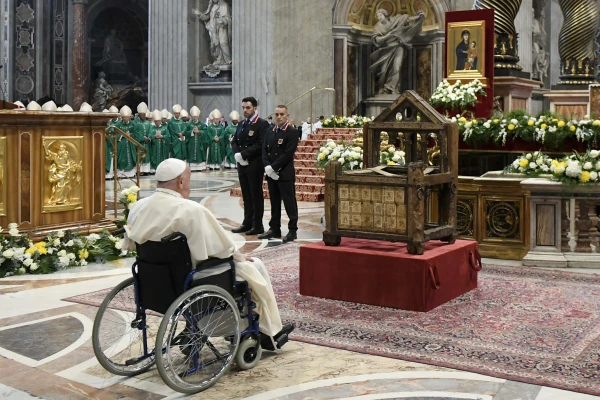Vatican City, Oct 27, 2024 / 08:55 am
Pope Francis closed the global Synod on Synodality’s final assembly on Sunday with a call for a Church that “hears the cry of the world” without being “blind” to the urgent issues facing our time.
At the synod’s closing Mass in St. Peter’s Basilica, Pope Francis said that a synodal Church must be “on the move” following Christ in serving those in need.
“We do not need a sedentary and defeatist Church but a Church that hears the cry of the world … and gets its hands dirty in serving the Lord,” the pope said in his homily on Oct. 27.
Pope Francis underlined that the Church cannot remain inert before “the questions raised by the women and men of today, the challenges of our time, the urgency of evangelization, and the many wounds that afflict humanity.”
“Brothers and sisters, not a sedentary Church, but a Church on her feet. Not a silent Church, but a Church that embraces the cry of humanity. Not a blind Church, but a Church, enlightened by Christ, that brings the light of the Gospel to others. Not a static Church, but a missionary Church that walks with her Lord through the streets of the world,” he said.

The Mass marked the conclusion of the second assembly of the 16th Ordinary General Assembly of the Synod of Bishops, which began on Oct. 2 and focused on the theme “For a Synodal Church: Communion, Participation, and Mission.”
The assembly represented a significant phase in the Church’s global synodal process, initiated three years ago. Over the last month, synod delegates produced a 52-page final document outlining recommendations for Church renewal, including proposals for expanded women’s leadership roles, greater lay participation in decision-making, and significant structural reforms.
In a notable departure from tradition, Pope Francis announced that he will forgo issuing a postsynodal apostolic exhortation. Instead, he opted to ratify the synod’s final document, directly implementing the assembly’s conclusions. While the synod assembly has ended, 10 synod study groups will continue to examine the question of women deacons and other key topics through June 2025.
In his homily, Pope Francis reflected on the Gospel of Mark’s account of Jesus healing a blind man named Bartimaeus. He said that “blind Bartimaeus … represents that inner blindness which restrains us, keeps us stuck in one place, holds us back from the dynamism of life, and destroys our hope.”

“So many things along the way can make us blind, incapable of perceiving the presence of the Lord, unprepared to face the challenges of reality, sometimes unable to offer adequate responses to the questions of so many who cry out to us,” the pope said.
“A sedentary Church, that inadvertently withdraws from life and confines itself to the margins of reality, is a Church that risks remaining blind and becoming comfortable with its own unease,” he said. “If we remain stuck in our blindness, we will continuously fail to grasp the urgency of giving a pastoral response to the many problems of our world.”
Pope Francis, dressed in green vestments for the 30th Sunday in Ordinary Time, delivered his homily slowly, often pausing to speak off the cuff. He described an image of a “synodal Church” as one in which “the Lord is calling us, lifting us up when we are seated or fallen down, restoring our sight so that we can perceive the anxieties and sufferings of the world in the light of the Gospel.”
“Let us remember never to walk alone or according to worldly criteria,” he added, but instead to journey by “following Jesus along the road.”
At the altar, Cardinal Mario Grech, secretary-general of the General Secretariat of the Synod, served as the principal celebrant.
(Story continues below)

More than 300 priests and bishops, 70 cardinals, and nine patriarchs concelebrated the synod’s closing Mass under the canopy of the recently restored baldacchino over the central altar.
The 400-year-old intricate bronze canopy designed by Gian Lorenzo Bernini was revealed at the Mass for the first time since restoration, its twisted columns gleaming with intricately decorated Baroque angels, cherubs, bees, and golden laurel branches.
“As we admire Bernini’s majestic baldacchino, more sublime than ever, we can rediscover that it frames the true focal point of the entire basilica, namely the glory of the Holy Spirit,” the pope said. “This is the synodal Church: a community whose primacy lies in the gift of the Spirit, who makes us all brothers and sisters in Christ and raises us up to him.”
As the Mass concluded, Pope Francis, from his wheelchair, led the faithful in the veneration of a relic of St. Peter’s chair — a wooden throne symbolizing the papal primacy. This relic is expected to remain on display in St. Peter’s Basilica for public veneration until Dec. 8.
“Today, as we give thanks to the Lord for the journey we have made together, we will be able to see and venerate the relic of the carefully restored ancient chair of St. Peter,” Pope Francis said. “As we contemplate it with the wonder of faith, let us remember that this is the chair of love, the chair of unity, and the chair of mercy.”







